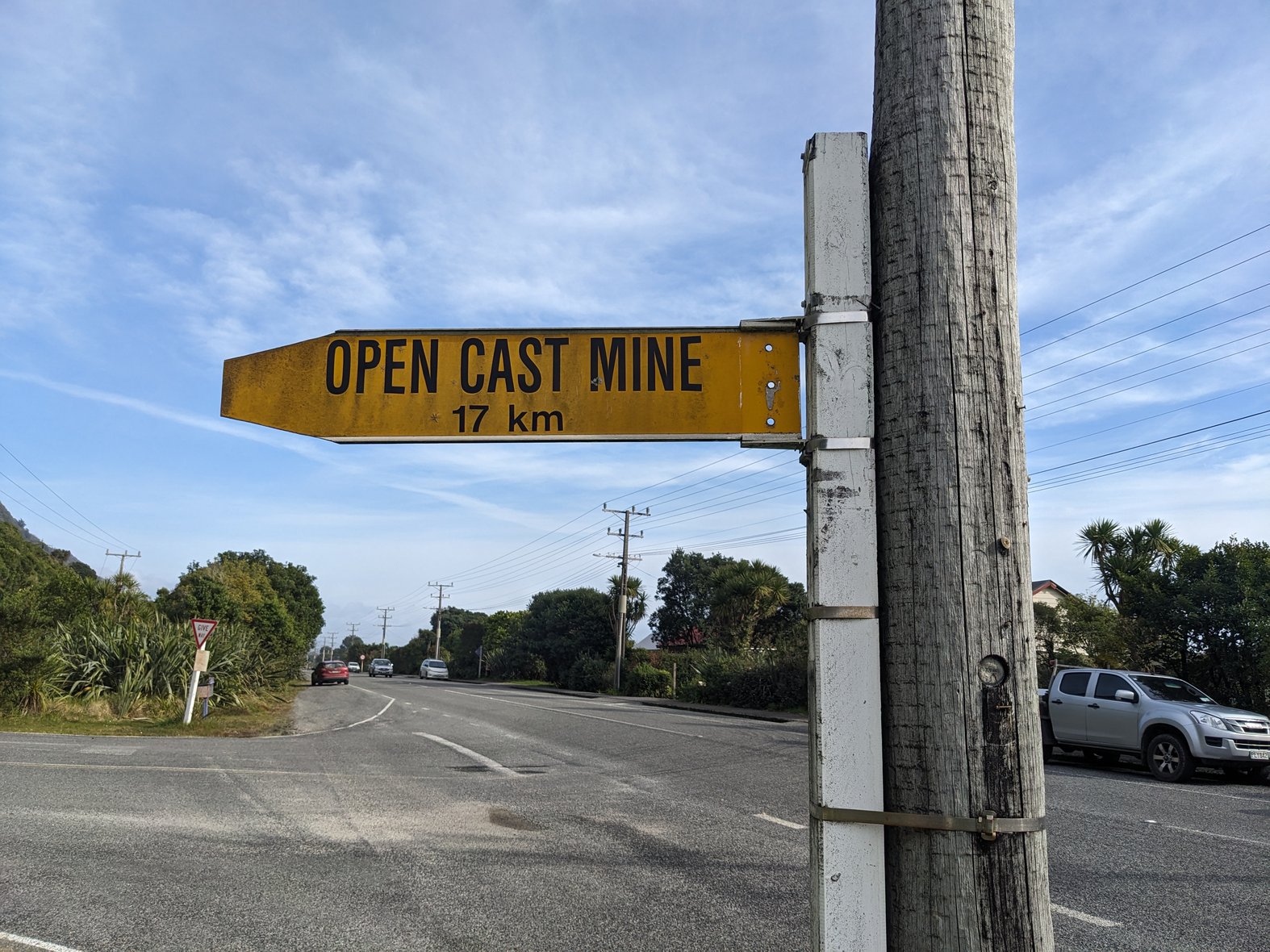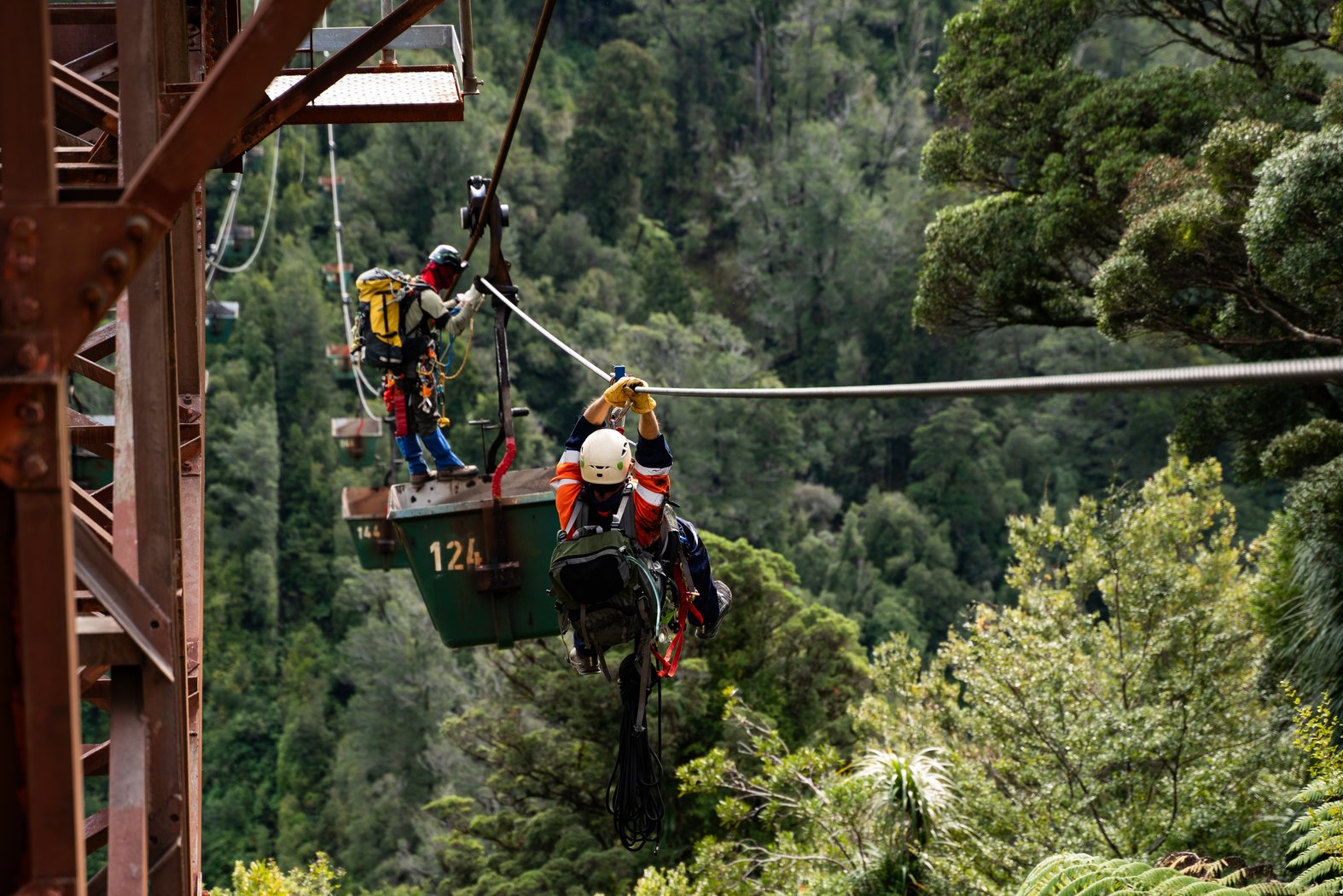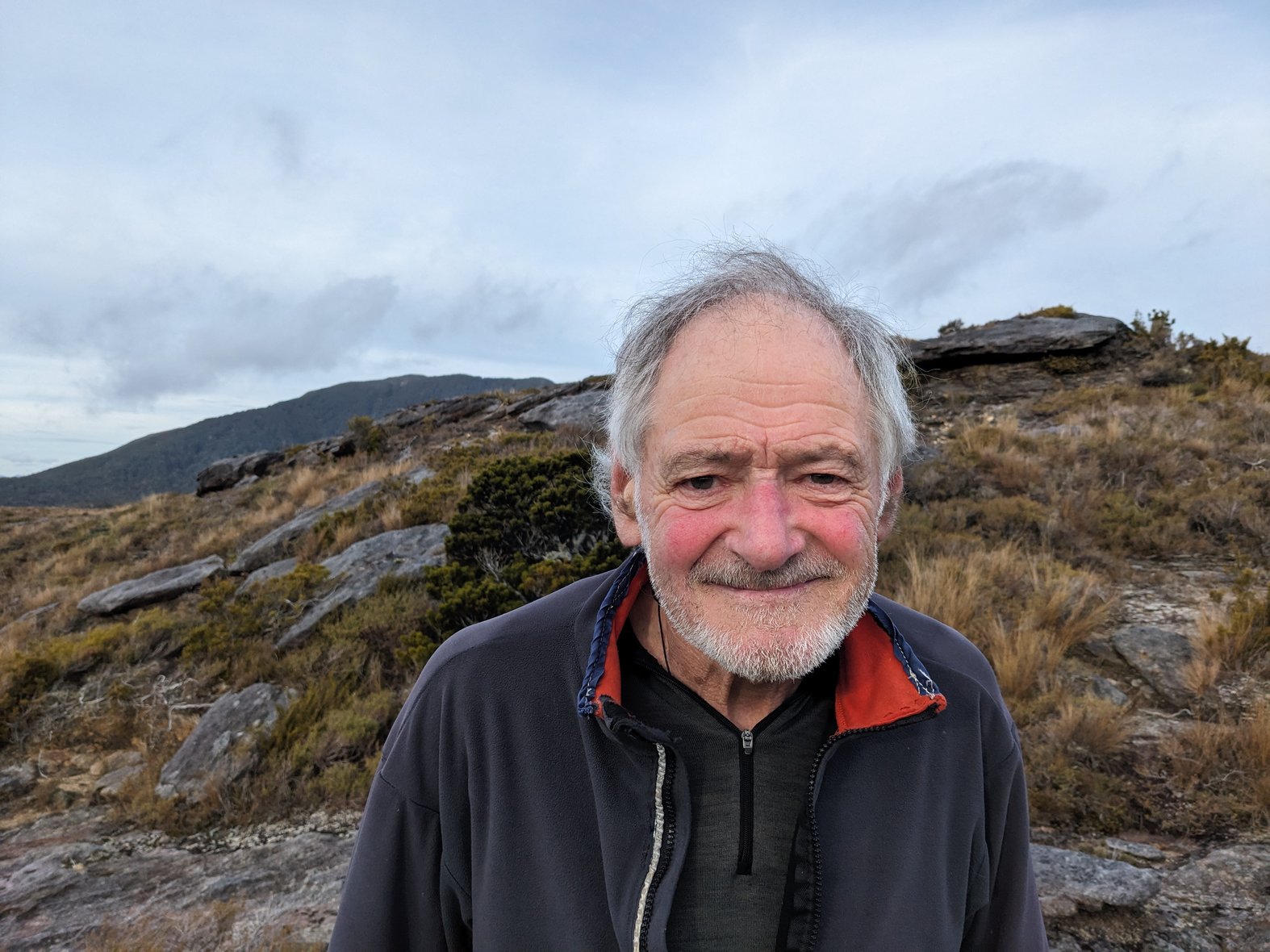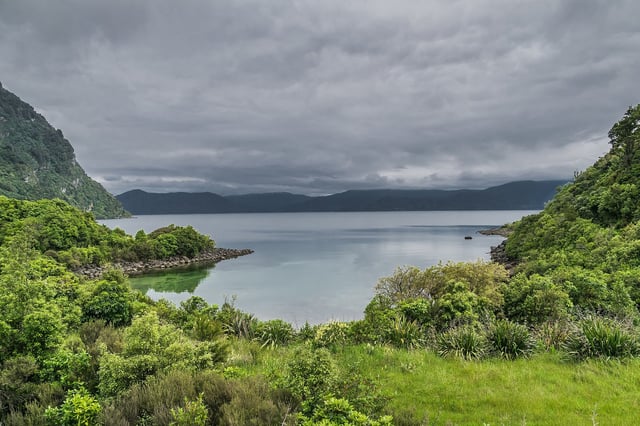
Photo: Road to Stockton Mine, on New Zealand’s South Island. Photo by Shanti Mathias.
Nestled amongst the lush, dark rainforest of the West Coast of New Zealand’s South Island is a cafe named for the area’s dominant industry: Coalface Cafe. Behind Ngakawau’s Coalface Cafe is the train line, carriages loaded with coal. Behind that is a two-kilometer long cableway, capable of transporting 289 tonnes of coal an hour from the mine over the ridge.
It’s early afternoon on a weekday but the cableway is still, the metal buckets dangling over the hillside. Somewhere behind the hill, two activists from the group Climate Liberation Aotearoa are sitting in one of the coal buckets. They reached it by an arduous four-hour trek through the dense forest. They then harnessed themselves in and used the cable as a kind of zipline to reach the bucket, filling it with supplies: dehydrated food, fuel for their stove, warm layers. While they stayed there, the cableway could not operate.
“The scenery is gorgeous, apart from the mining infrastructure,” said Rach Andrews, one of the activists in the bucket. Drilled spoke to her two days into the occupation, at the end of July; she and Tāmati Taptiklis stayed in the bucket for 23 days, significantly delaying production at Stockton coal mine, New Zealand’s largest. The business says it cost about $30,000 a day not to be able to operate the cableway, a bill of approximately $600,000 in total. Taptiklis and Andrews have been charged with trespass and unlawful conversion of a vehicle (the coal bucket) into a house. The trial will be later this year, and while on bail they are banned from contacting each other.

Coalface cafe. Photo by Shanti Mathias.
To make coal mining easier, change regulations
Stockton coal mine has been operating in various forms since the 1890s. It’s owned by Bathurst Resources, a New Zealand-based company, majority owned by Singaporeans but listed on the Australian stock exchange. Originally started in Perth, Australia, Bathurst has also operated mines in Kentucky, but has been focused on producing coal in New Zealand since 2010.
On current projections, Stockton has about three years of coal left. Bathurst has applied for a permit to open a mine on the Denniston plateau, which adjoins Stockton. There’s a seam of coal about 50 meters under the ground: accessing it will require blasting through bedrock.
There are numerous pieces of legislation which govern mining in New Zealand, meaning it can take years to get a permit. But this proposed coal mine has an advantage: it’s been placed on the Fast-track list, legislation passed in 2024 in New Zealand to allow ministers to select projects to be approved more quickly, circumventing normal legislative processes. The panel can choose which interested parties are allowed to give evidence about the application.
“This single mine alone would blow our climate targets out of the water,” said Adam Currie, a campaigner from the Aotearoa New Zealand branch of 350.org, who occupied the coal buckets for several days in an April protest. “[The Fast-track] allows a small group to approve or deny projects, and even override Supreme Court judgements. It rides roughshod over democratic and local government protections.”
“It can take years and years to get [a mining permit],” said Patrick Phelps, spokesperson for Minerals West Coast, a lobby organization funded by Bathurst. He rattled them off: the Wildlife Act, the Crown Minerals Act, health and safety law, approval from the minister of conservation. “The Fast-track puts all of the laws in one place.” It’s clearly good news for the company’s profitability, with Bathurst CEO Richard Tacon saying he was “extremely pleased” about the law in a December 2024 letter to investors.

The Denniston plateau. Photo by Shanti Mathias.
The coal company next door
In the small museum in Westport, New Zealand, there’s a video voiced from the perspective of coal. Animated trees are crushed and slid under the earth, getting darker, before they are pushed to the surface again. “I carry limitless, pure energy,” says the coal, its voice silky and confident.
There are notable absences in the museum display. No mention of climate change, for one. There are photos of the thousands of people once employed in company towns around the West Coast from 1870s onwards – but nowhere does it talk about the closures, which mean that number is now reduced to about 390 jobs in Buller, and 50 more contractors located elsewhere.
Bathurst does invest in the community. For example, it funds the Buller Resilience Trust, which issues community grants to local initiatives. District mayor Jamie Cleine and Bathurst CEO Richard Tacon are both on the board; one of the organization’s stated goals is to support the “emergence of new, sustainable, low-emissions sectors/industry” in the district.
Westport, Buller’s biggest town, has just 4,600 residents, meaning more than 10% of working-age people are employed by the coal mine. Major floods in 2021 and 2022 caused millions of dollars of damage, and the local council is working on a “Resilient Westport” plan which would begin moving housing to higher ground as properties become uninsurable.
In the reality of climate-exacerbated natural hazards, too, the local fossil fuel company makes itself indispensable. When responding to the floods, Bathurst has offered its staff and equipment. “They put their manpower and skillset at our disposal,” Cleine said. “They help provide lighting towers and pumps, it would be really missed if they weren’t here.”
Royalties from the mining industry, he said, keep the district afloat, providing services like the local pool and library. “It’s not just to justify social license, they underpin so much; so much into the health sector and sports and all of that.”
Not everyone buys that narrative. “Public services exist all over the country without coal companies propping them up,” said Suzanne Hills, a local Forest and Bird volunteer. “What they put back into the community is absolute peanuts compared to the profits they extract.”
In the 2024 financial year, Bathurst made $315 million (Australian dollars) in revenue; it says it spends $78 million (NZ) on direct employment in New Zealand, as well as taxes, royalties and supplies. The new mine proposes to extract 20 million tonnes of coal; on current (ever-changing) coking coal prices, the mine could make $3.5 billion (US) over approximately 25 years of operation. That coal would also produce approximately 50 million tonnes of carbon dioxide, which is more carbon dioxide than New Zealand currently emits in a year.

Activists clime the coal ropeway. Photo courtesy Climate Liberation Aotearoa.
Coal culture, threats and violence
Activists opposing the mine have experienced the pointy end of coal culture. A message sent to Climate Liberation Aotearoa on Facebook, and seen by Drilled, from a Facebook account belonging to a mine employee, threatened the group. “Angry, upset locals have been busy collecting information on you…I would strongly suggest that it would not be very wise for any of you to be seen within our district over the next few months, years, or if at all ever,” read part of the message.
While occupying the coal bucket, Taptiklis and Andrews said multiple warning shots were fired at them, in volleys of three. Bathurst denies that they were involved in the gunshots, with CEO Tacon saying the company didn’t employ “anyone stupid enough” to use firearms.
On 14 August 2025, a group of students from the local polytechnic went on a field trip to visit the proposed mine site. While they were exploring Denniston, their vans were totally burned, leaving only the metal frames. “There’ve been coal protests up there in recent times. And currently there’s climate action people in a bucket on the aerial ropeway from Stockton Mine which is 20km up the coast. So a lot of questions needing answers,” wrote Pete Lusk, who came across the vans, in a Facebook post.
Although there’s no evidence of who burned the vans, activist Currie says there is a history of violence towards pro-environment voices in the area. “Those threats are increasingly being realized,” he told Drilled.
“There’s a lot of conservationists on the West Coast, but they’re often too nervous to put their head up on the parapet, because so many people are pro-mining,” said Neil Silverwood, a West Coast photographer. Shane Jones, New Zealand’s resource minister, described activists at an action in April as “blow-ins from other parts of the country” – but multiple locals Drilled talked to said they were afraid of the public repercussions of opposing the mine. A nationwide poll shows that 45% of New Zealanders support mining. While there’s no regional level polling, support in the West Coast is much higher. “Having these people come, it’s like, thank God someone’s come to help,” said K. a woman who lives in a small community very close to the mine, and asked to use her initial for fear of retaliation.
Friends in the government
The Fast-track law is one piece of support from the New Zealand government. But it’s clear the mining industry has more than that. A scan of resource minister Jones’ diary, released to the public, shows that he has met Tacon, Bathurst’s chief executive, at least three times since the start of 2024. He has also attended a forum and meeting with lobby group West Coast Minerals, visited the Stockton coal mine and another West Coast mine run by a company called Roa.
Jones initially did not release details of the visit to Roa and a gold mine in his diary, which is required to be public. “I don't think there's much I can do, quite frankly, to overcome the perception that there is a cosy relationship between myself and both the fishing industry and the mining industry. Socially, I bump into [executives] at the rugby. I go and see them in their offices. I invite them to my office,” he told local paper Westport News.
In a similar fashion to Donald Trump declaring he would “drill, baby, drill,” Jones has sought to connect coal mining with New Zealand identity. Following the July coal bucket occupation, he released a video standing in front of the New Zealand flag, discussing the ICJ opinion on climate change. “Coal is essential to keeping the lights on, essential to jobs. We’re not going to back down because some advisoral [sic] opinion has floated down from the northern hemisphere.”
In June, speaking in New Zealand’s parliament, Jones linked his support of coal to the government’s decision to reverse New Zealand’s previous ban on oil exploration. “Don’t seek to convince Kiwis that you’re going to keep the lights on with more sunlight and more wind,” he said. “Because of the wretched decision to destroy the gas industry we are the only western nation transitioning to coal.” The decision to restore gas prospecting, as well as other policies, were part of why New Zealand left the Beyond Oil and Gas Alliance. Local member of parliament Maureen Pugh is also supportive of mining, and has advocated for a regional-specific version of the Fast-track law explicitly for mining consents.
Corporations are picking up on the change in attitude. A survey from a free-market Canadian think-tank ranked New Zealand as the world’s 12th-most friendly country for mining in 2024, after being ranked 72 in 2021.

Denniston resident Terry Sumner. Photo by Shanti Mathias.
When coal is gone, what remains?
“It just breaks my heart to look up there,” said Terry Sumner, still wearing the hi-vis jacket he used to bike 40 kilometers from Westport to his home in Denniston, up a big hill. Once a booming mining town with 1,500 people, multiple schools, a pool, and a post office, Denniston is now home to just half a dozen; Sumner is one of them. We’re looking at the Escarpment Mine, a Bathurst property opened in 2014. Coal mining was carried out for two years, before the international coking coal price dropped, and the mine was put into what the company calls “care and maintenance”, on hold until it can make more money. The bare, scraped earth, which Sumner described as a “scar”, was once a valley where his children played.
The Escarpment mine is just the most recent chapter in the story of coal work leaving the West Coast when it stops being economical for a company to extract. “I come from a mining town – not a single person is employed in mining any more,” said Silverwood. “Coal resources are really marginal – dropping the coking coal prices could knock the whole thing over.”
Cleine, the Westport mayor, acknowledges that at some point the town will have to transition away from reliance on coal jobs. “We know coal is not there forever, we need to start planning for life without coal now,” he said. But the three to five years the current mine buys them isn’t going to be enough, he said. “It’s just not feasible for there to be an economic replacement when Stockton closes… 30 years would give us time to develop more tourism or local electricity sources to power some manufacturing”
Regardless of the outcome of its Fast-track proposal, Bathurst is willing to look elsewhere. In 2023, it acquired Tenas, a coal mining operation in British Colombia, Canada, which is expected to begin producing coal in the 2027 financial year and is currently receiving environmental approval. It also has an interest in Crown Mountain, another joint-venture coal operation in British Colombia.
Mine closures are not new here. Sumner showed Drilled around Denniston: the broken pool, gated dark mouths that were once functioning underground mines, capped drill holes where surveyors came looking for a seam. There was even a rotting leather boot, with marks from the hobnails still in it.
Among the human detritus, small plants crept across the ground and lichens made elaborate castles on the sandstone. Denniston’s ecological uniqueness, with rare lichens, snails and endangered kiwi, have been a key focus of protest action, with Climate Liberation Aotearoa and Forest and Bird inviting ecologists to talk about the species in the area. Snails removed when the Stockton mine opened died when the temperature control on their fridge malfunctioned.
“We’ve got a climate catastrophe going on,” said Sumner. His old house rattles with strong winds and sudden downpours; he’s been able to grow lettuces for the first time, never before possible on the chilly plateau.
This trash is from a century and a half of extraction, even before the modern tools of open-face mines. As the campaign to oppose this mine continues, the debris is a reminder that when the coal is gone, there is always stuff, and people, left behind. What can’t be seen, of course, is the other effect of mining and burning coal: molecules of carbon dioxide floating in the atmosphere far above. The only reminder of those is Sumner’s lettuce seedlings, ready for another, warmer springtime.

